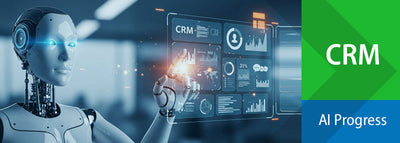Manufacturing Resource Planning (MRP II) Systems: Essential Features for Your Business in 2025
Keeping a manufacturing operation running smoothly is no small feat. Material costs keep fluctuating, supply chain delays are becoming more common, and competition is fiercer than ever. To stay ahead, manufacturers need more than just experience, they need the right technology. Manufacturing Resource Planning (MRP) systems are key to maintaining operational efficiency, improving production output, and reducing costs.
With the pace of technological change including the rapid adoption of AI, understanding what modern MRP systems offer is more important than ever. In this article, we’ll explore the key features to look for, and the differences between MRP, MRP II and ERP, to help make an informed decision about the software technology and specific solutions best suited to enhance your manufacturing operations.
What is Manufacturing Resource Planning (MRP)?

Manufacturing Resource Planning (MRP II) is designed to help manufacturers manage their inventory, production schedules, and resource allocation efficiently, focused on tracking materials and ensuring inventory levels meet production demands. The concept started as Material Requirements Planning (MRP I), on tracking materials and ensuring inventory levels met production demands. Over time, this evolved into MRP II, which integrated broader functions such as capacity planning, production scheduling, and linking with other business processes like sales and finance.
Modern MRP systems are comprehensive tools that help streamline all stages of the manufacturing process from materials planning to final production making them crucial for businesses looking to optimize operations and improve efficiency.
Why MRP Matters
In today’s manufacturing landscape, the importance of MRP systems cannot be overstated. According to various industry reports and manufacturing experts, Material Requirements Planning (MRP) systems can potentially reduce production downtime by up to 30% and decrease material waste by 25%. With manufacturing costs expected to increase annually, investing in a robust MRP system can not only save money but also help improve operational efficiency and reduce risk.
Benefits of MRP Systems

Implementing an MRP system brings numerous advantages to manufacturing businesses. Here’s how it can benefit your operations:
-
Better Resource Utilization
MRP systems ensure that resources—whether materials, machines, or labor—are used efficiently. By keeping track of inventory and production needs, they help minimize downtime and maximize production output.
-
Improved Collaboration Across Teams
With real-time data shared across departments, everyone—from production to accounting—has access to the same information. This reduces errors, improves communication, and enables quicker decision-making across teams.
-
Optimized Inventory Management
One of the biggest challenges for manufacturers is balancing inventory levels. MRP systems provide a clear picture of inventory needs, reducing both excess stock and stockouts. This helps maintain smooth operations and avoid production delays.
-
Time and Cost Savings
Automation is a key feature of modern MRP systems. By automating routine tasks, such as inventory tracking and scheduling, MRP systems reduce the need for manual input and minimize human errors. This leads to cost savings, increased efficiency, and more time to focus on strategic initiatives.
-
Informed Decision-Making
With data at your fingertips, MRP systems enable better decision-making. You can quickly identify production bottlenecks, track performance metrics, and make adjustments in real-time to ensure everything is running smoothly.
-
Scalability
As your business grows, your MRP system can grow with you. Whether you're adding more products, expanding your facilities, or increasing your workforce, a scalable MRP system can handle the added complexity without missing a beat.
MRP vs. MRP II vs. ERP: Key Differences
Although MRP, MRP II, and ERP systems all play a role in optimizing manufacturing processes, they each have distinct purposes. Here’s a breakdown of how they differ:
|
Feature |
MRP (Material Requirements Planning) |
MRP II (Manufacturing Resource Planning) |
ERP (Enterprise Resource Planning) |
|
Focus |
Inventory management and material planning |
Broader manufacturing management, including scheduling, capacity, and resource planning |
Enterprise-wide business functions (finance, HR, supply chain, production, etc.) |
|
Scope |
Primarily inventory and materials |
Production scheduling, inventory, capacity planning, and integration with business functions like finance and sales |
Covers all departments, including finance, HR, supply chain, production, and more |
|
Integration |
Basic, typically within inventory and production |
Comprehensive within manufacturing functions but can be linked to other departments |
Full integration across all business functions |
|
Automation |
Limited automation, mainly material ordering and inventory tracking |
Includes automation of production scheduling, resource planning, and more |
Automation across all business processes, from finance to supply chain management |
|
Data Analysis |
Basic forecasting and demand analysis |
Advanced analysis with predictive analytics for production and resource allocation |
Comprehensive business analytics for decision-making across all areas |
|
Real-Time Data |
Limited real-time data tracking |
Real-time data for production, inventory, and capacity planning |
Real-time data across all departments for holistic decision-making |
|
Best For |
Small to mid-sized manufacturing companies needing basic inventory control |
Medium to large manufacturers needing comprehensive production and resource planning |
Large enterprises with complex needs across multiple departments |
|
Examples of Functions |
Material ordering, inventory management |
Production scheduling, resource planning, capacity management, and integration with finance |
Finance, HR, inventory, production, supply chain, customer relationships, and more |
Which One Is Right for You?
-
MRP is ideal if you are focused on inventory and material management and need basic support for your production planning.
-
MRP II is perfect for medium to large manufacturers that require a more advanced and integrated approach to production, scheduling, and resource management.
-
ERP is best suited for large enterprises looking for a fully integrated solution that covers all aspects of business management.
Essential Features of an MRP System in 2025
As technology continues to advance, modern MRP systems need to offer more than just basic inventory management. Here are the key features to look for in an MRP system for 2025:
AI-Driven Inventory Management
Efficient inventory management is a significant challenge for many manufacturers. Too much stock can tie up cash flow, while too little can lead to production delays. Modern MRP systems incorporate artificial intelligence (AI) to predict demand and optimize inventory levels. This reduces the chances of overstocking or running out of essential materials, leading to better cash flow and more reliable production schedules.
Advanced Manufacturing Scheduling
A well-organized production schedule is essential to keeping operations running smoothly. Advanced scheduling software helps manufacturers automatically create schedules based on real-time data, including machine availability, workforce capacity, and material availability. By reducing scheduling errors and production bottlenecks, this feature ensures a more efficient use of resources and improved on-time delivery.
Cloud-Based Systems for Greater Flexibility
Cloud-based MRP systems offer the flexibility to access critical business data from any location. Whether you're working from the shop floor or managing operations remotely, cloud-based systems provide real-time data access, easier collaboration across teams, and lower IT maintenance costs. With the rise of global supply chains and remote work, this feature is becoming essential for manufacturers.
IoT Integration for Real-Time Monitoring
The Internet of Things (IoT) allows devices and machines to communicate and share data. When integrated with MRP systems, IoT sensors can monitor machine performance, track production processes, and even predict when maintenance is needed. This reduces unplanned downtime and keeps production on track, helping manufacturers maintain optimal efficiency.
Seamless ERP Integration
For manufacturers looking for an all-in-one solution, integrating MRP with ERP (Enterprise Resource Planning) software can provide a comprehensive view of the entire business. This integration allows manufacturers to manage not just production and inventory, but also finance, HR, and the supply chain in a unified system. This holistic approach supports better decision-making and cost control across all business functions.
Automated Bill of Materials (BOM) Management
Managing and updating a Bill of Materials (BOM) is critical for ensuring that every part and material needed for production is accounted for. Automated BOM management in MRP systems ensures accuracy and prevents costly errors, saving both time and resources. This feature allows manufacturers to track materials from the initial stages of production through to the final product, reducing the risk of missing components or over-ordering.
Integrated Quality Control
Quality control is a major concern in manufacturing, and modern MRP systems integrate quality assurance processes directly into production workflows. This ensures that each product meets the required standards and reduces defects. By incorporating quality checks at various stages of production, manufacturers can identify and address issues early, which ultimately leads to cost savings and fewer product recalls.
Real-Time Data Analytics and Reporting
The ability to analyze data in real time is crucial for improving production efficiency. Modern MRP systems offer real-time analytics that provide actionable insights into production performance, inventory levels, and potential bottlenecks. This data allows managers to make informed decisions quickly and optimize production workflows on the fly.
Demand Forecasting
Forecasting demand accurately can be difficult, but it is a vital part of successful manufacturing. MRP systems equipped with demand forecasting features use historical data, market trends, and seasonal patterns to predict future demand. This enables manufacturers to plan production schedules and inventory purchases in advance, reducing the risk of shortages or overstocking.
Customizable Dashboards and User Interfaces
Every manufacturing operation is unique, so a one-size-fits-all approach doesn't always work. MRP systems with customizable dashboards and user interfaces allow businesses to tailor their views to match their specific needs. This makes it easier for team members to access the information that is most relevant to them, improving decision-making and operational efficiency.
Future Trends in MRP Systems
The future of MRP is exciting, with several trends shaping the industry:
Blockchain for Supply Chain Transparency
Blockchain technology can help improve traceability and reduce fraud in the supply chain. This adds an extra layer of security and transparency to the materials sourcing process.
AI and Robotics in Manufacturing
AI-driven robotics and automation are becoming more prevalent in manufacturing, further boosting efficiency on the production floor. These technologies can optimize processes, reduce manual labor, and improve overall production accuracy.
Sustainability-Focused MRP
As sustainability becomes a priority, MRP systems will play an integral role in helping manufacturers reduce energy consumption, waste, and carbon footprints. These systems will enable smarter, more sustainable manufacturing practices.
Conclusion
As manufacturing operations grow increasingly complex, the need for a reliable, efficient MRP system becomes more critical. Whether you choose a specialized MRP system or a full ERP solution, the right system will help streamline your operations, improve inventory management, and drive overall business success.
Investing in an MRP system today will position your business for long-term success in 2025 and beyond.
Looking for the best MRP software? Explore our in-depth comparison of top manufacturing ERP solutions to find the right fit for your needs.
Helpful Resources for Choosing the Right Manufacturing ERP
Looking for more insights on MRP and ERP systems? Here are some great resources to check out:
- Manufacturing ERP Features and Requirements Checklist – Check out the checklist
- The Best Process Manufacturing ERP Software of 2025 – See the list
- The Best Production Scheduling Software for Manufacturing in 2025 – Take a look
- Compare Top Manufacturing ERP Software Leaders – Compare now
- Get a Manufacturing ERP Software Requirements Template - Download it here






